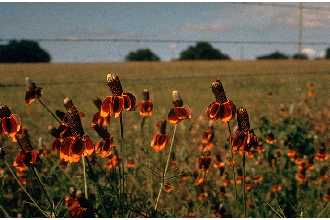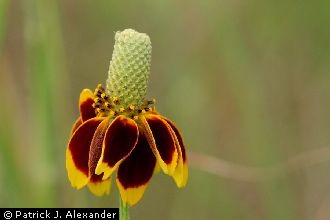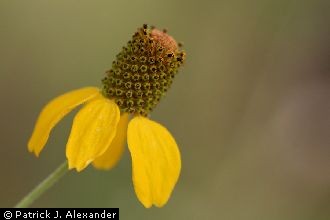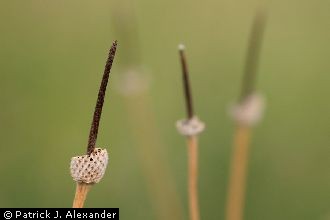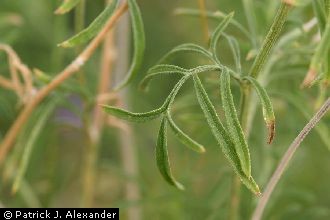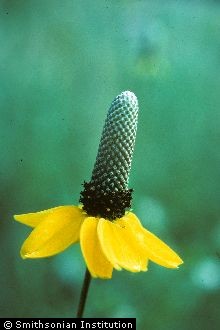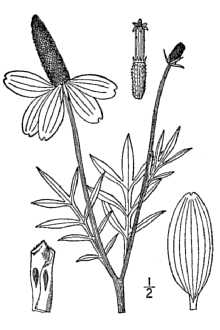Rudbeckia columnaris Pursh, non Sims
Scientific Name: Rudbeckia columnaris Pursh, non Sims
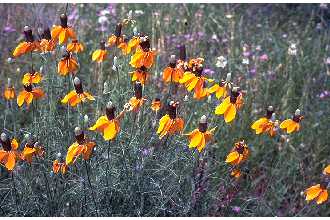
| General Information | |
|---|---|
| Usda Symbol | RUCO23 |
| Group | Dicot |
| Life Cycle | Perennial |
| Growth Habits | Forb/herb |
| Native Locations | RUCO23 |
Plant Guide
Alternate Names
Mexican hat, yellow Mexican hat, upright prairie coneflower, long-head coneflower, columnar prairie coneflower
Uses
Ethnobotanic: Tea was made from the leaves and flower heads. Cheyenne Indians boiled prairie coneflower leaves and stems to make a solution applied externally to draw the poison out of rattlesnake bites. An infusion was used to relieve the pain of headaches and to treat stomachaches and fevers (Moerman 1998). A decoction was used as a wash to relieve pain and to treat poison ivy rash (Ibid.). Landscaping: Prairie coneflower is suggested for use in roadside plantings, parks, recreational areas and prairie restoration projects; where annual precipitation is from ten to thirty inches. This species is sometimes grown as an ornamental.
Status
Please consult the Plants Web site and your State Department of Natural Resources for this plant’s current status, such as, state noxious status and wetland indicator values. @ PLANTS
Description
General: Composite Family (Asteraceae). Prairie coneflower is a native perennial about a foot and a half tall. The rays are generally three to five centimeters long, much longer than the disk (solid part between the rays). The floral disk is somewhat globe-shaped, ovoid, or shortly ellipsoid, twelve to twenty millimeters high (Steyermark 1963). Prairie coneflower has well-developed leaves up to fifteen centimeters long and six centimeters wide, pinnatifid to partly bipinnatifid, with ultimate segments linear to oblong, often very unequal (Great Plains Flora Association 1986). This species has one to several stems twelve to forty-seven inches tall. The fruit is a small ashen. Distribution: Prairie coneflower ranges from Alberta to Mexico, east to Manitoba, Minnesota, Illinois, Missouri, Arkansas, Oklahoma, Texas; and New England (Steyermark 1963). For current distribution, please consult the Plant profile page for this species on the PLANTS Web site.
Adaptation
Ratibida columnifera grows well on loam, sandy loam, and clayey loam soils, Use soil moisture sensors to measure the soil moisture of Rudbeckia columnaris Pursh, non Sims., It prefers a sunny position and well-drained rich soil types, This species is tolerant of weakly acidic to moderately alkaline soils and weak saline soils, It has low to moderate water requirements, Prairie coneflower is found on dry plains, prairies, waste ground, and along roadsides and railroads,
Establishment
Propagation by Seed: Ratibida columnifera seeds are best sown in early spring in a cold frame. Cover the seeds and place the pot in a sunny location. Optimum germination temperatures are between 68 to 86ºF, or 20 to 30ºC. Germination should be achieved in two days.
Management
Prairie coneflower seeds can be planted in the fall. If they are placed in winter storage for spring planting, they should be stratified with a cold dry treatment. Cultivars, Improved and Selected Materials (and area of origin) Available through native plant seed sources specializing in Great Plains species. Contact your local Natural Resources Conservation Service (formerly Soil Conservation Service) office for more information. Look in the phone book under ”United States Government.” The Natural Resources Conservation Service will be listed under the subheading “Department of Agriculture.”
References
Bare, J. E. 1979. Wildflowers and weeds of Kansas. The Regents Press of Kansas, Lawrence, Kansas. Bruggen, T. V. 1976. The vascular plants of South Dakota. The Iowa State University Press, Ames, Iowa. Dorn, R. D. 1984. Vascular plants of Montana. Mountain West Publishing, Cheyenne, Wyoming. Harrington, H. D. 1964. Manual of the plants of Colorado. 2nd ed. The Shallow Press Inc., Chicago. Looman, J. & K. F. Best. 1994. Budd’s flora of the Canadian Prairie Provinces. Minister of Supply & Services Canada, Ottawa, Canada. Moerman, D. 1998. Native American ethnobotany. Timber Press, Oregon. Nelson, R. A. 1977. Handbook of Rocky Mountain plants. 2nd ed. Skyland Publishers, Estes Park, Colorado. Sharp Brothers Seed Company 1989. Catalog of wildflowers and forbs. Sharp Brothers Seed Company, Amarillo, Texas. Steyermark, J. A. 1963. Flora of Missouri. The Iowa State University Press, Ames Iowa. Straughbaugh, P. D. & E. L. Core 1977. Flora of West Virginia. 2nd ed. Seneca Books, Inc., Morgantown, West Virginia. The Great Plains Flora Association 1986. Flora of the Great Plains. University Press of Kansas, Lawrence, Kansas. Vance, F. R., J. R. Jowsey, & J. S. McLean 1984. Wildflowers of the northern Great Plains. University of Minnesota Press, Minneapolis, Minnesota. Weber, W. A. 1987. Colorado flora: western slope. Colorado Associated University Press, Boulder, Colorado.
Fact Sheet
Alternate Names
Upright prairie coneflower, yellow coneflower, long headed coneflower, columnar prairie coneflower, Mexican hat
Uses
Grazing: Prairie coneflower is palatable and nutritious to all classes of domestic livestock when utilized in early stage of plant growth and development. It is considered a desirable spring browse plant for big game animals, and the seed of prairie coneflower is preferred by several species of upland birds and small mammals. Restoration: Prairie coneflower is a medium to tallstatured forb that may fill a structural cover and nesting niche for multiple species of upland birds in a variety of plant community types. A more diverse native plant community will be attained when this species is included in native seed mixes for the rehabilitation of such disturbed sites as rangelands, minelands, roadsides, park and restoration areas, prairie restoration projects, and conservation plantings in accordance with government farm bill program requirements. Landscape: Prairie coneflower is commonly recommended as an ornamental wildflower in pollinator friendly, low maintenance, or natural landscapes. Ethnobotanic: Native peoples utilized a decoction of leaves and stems to treat pain, poison ivy rash, and rattlesnake bites. An infusion was made from plant tops to treat headache, stomachache, cough, fever, epileptic fits, and to induce vomiting. A medicinal or beverage-type tea was made from the ripened flower heads and leaves. An orange-yellow dye was produced from boiled flowers.
Status
Please consult the PLANTS Web site and your State Department of Natural Resources for this plant’s current status (e.g. threatened or endangered species, state noxious status, and wetland indicator values).
Description and Adaptation
Adaptation , Use soil moisture sensors to measure the soil moisture of Rudbeckia columnaris Pursh, non Sims.
Adaptation
Prairie coneflower is a native, late-season, herbaceous perennial in the Aster Family. It usually has a taproot and grows upright from a woody base to a height of 12 to 24 inches (30 to 60 cm). The numerous, pinnate leaves are deeply cut into linear or lance-shaped segments along alternately branched stems. Showy yellow ray flowers droop and surround the columnar-shaped, brown, central disk. Occasionally, the ray flowers are reddish-brown in color. The flowers tend to bloom from late June until August, with seed ripening completed in early August to September. The mature seedhead has a pleasant odor when crushed that is similar to anise or licorice. The fruit is a 1-seeded, gray-black achene. Prairie coneflower is a native, drought-tolerant wildflower of the Great Plains that is commonly found from south central Canada to northern Mexico, and west from Manitoba and Minnesota to southeastern Idaho. It prefers to grow in the dry, open spaces of prairie grasslands and mountain foothills and is found along roadsides, in waste and disturbed areas, and along railroad rights-of-way. Prairie coneflower does well on a variety of soil types, including loams and rocky to gravelly-sandy textures. It tolerates a pH range from slightly acidic to moderately alkaline and weak saline soils, in areas receiving 10 to 30 inches (254 to 762 mm) of annual precipitation. Prairie coneflower attains optimum growth in full sun and low to moderate levels of competition within a native plant community. This plant is a common component of such ecological Plant Materials <http://plant-materials.nrcs.usda.gov/> Plant Fact Sheet/Guide Coordination Page <http://plant-materials.nrcs.usda.gov/intranet/pfs.html> National Plant Data Center <http://npdc.usda.gov>
Establishment
Seed should be planted into a firm, weed-free seedbed, preferably with a drill that will ensure uniform seed placement depth of ¼ to ½ inch (6 to 12 mm). The processed seed of prairie coneflower has approximately 600,000 seeds/lb (1,320,000 seeds/kg). The full seeding rate is 2 lb/acre (2.2 kg/ha) pure-live-seed (PLS), but it would seldom be seeded in a pure stand. It is recommended that prairie coneflower be included as a component of a native seed mixture at a rate of ¼ to ½ lb/acre (0.3 to 0.6 kg/ha). When used in a mix adjust the seeding rate to the desired percentage of mix. Spring seeding is preferred over a dormant, fall planting date. Periodic mowing during the establishment year is one option for weed suppression. Seed
Production
Seed production fields should be established in rows at 25 PLS per linear foot of row (82 per linear meter of row). Between-row spacing is dependent on the type of planting and cultivation equipment, and ranges from 24 to 36 inches (60 to 90 cm). Adequate between-row space should be provided to perform mechanical cultivation. At 24-inch row spacing, the recommended seeding rate is 1 PLS lb/acre (1.1 kg/ha), and at 30- and 36-inch row spacing, the seeding rate is 0.7 and 0.6 PLS lb/acre (0.8 and 0.7 kg/ha), respectively. There are presently no herbicides specifically labeled to control weeds in seed production fields. Seed harvest of prairies coneflower is effective by several methods such as swathing and combining or direct-combining. Direct-combining should take place when the seed has just begun to shatter from the very top of the ripened conehead. Processing of the seed works well over a 2- to 3-screen fanning mill with final cleaning over an indent cylinder or gravity table. Seed production of 300 to 500 lb/acre (336 to 560 kg/ha) can be expected under irrigated conditions. Seed production stands may remain productive for only 3 years (2 seed crops). Seed viability is very high and longevity can be expected for 5 to 8 years when stored at moderate temperatures and low humidity.
Management
Growth of prairie coneflower begins in mid spring and flowers begin to appear in early summer. Excessive competition from other species may require removal to promote prairie coneflower establishment and longevity. Livestock grazing and wildlife browsing should be limited to avoid over-utilization during the active growing season.
Pests and Potential Problems
There are no major insect or disease pests of prairie coneflower. Stands can be reduced by powdery mildew and root and crown rot organisms.
Plant Traits
Growth Requirements
| Temperature, Minimum (°F) | -43 |
|---|---|
| Adapted to Coarse Textured Soils | Yes |
| Adapted to Fine Textured Soils | Yes |
| Adapted to Medium Textured Soils | Yes |
| Anaerobic Tolerance | None |
| CaCO3 Tolerance | Low |
| Cold Stratification Required | No |
| Drought Tolerance | Medium |
| Fertility Requirement | Medium |
| Fire Tolerance | High |
| Frost Free Days, Minimum | 90 |
| Hedge Tolerance | None |
| Moisture Use | Medium |
| pH, Maximum | 7.0 |
| pH, Minimum | 5.9 |
| Planting Density per Acre, Maxim | 4800 |
| Planting Density per Acre, Minim | 2700 |
| Precipitation, Maximum | 40 |
| Precipitation, Minimum | 16 |
| Root Depth, Minimum (inches) | 14 |
| Salinity Tolerance | Low |
| Shade Tolerance | Intolerant |
Morphology/Physiology
| After Harvest Regrowth Rate | Slow |
|---|---|
| Toxicity | None |
| Resprout Ability | No |
| Shape and Orientation | Erect |
| Active Growth Period | Summer |
| Bloat | None |
| C:N Ratio | Medium |
| Coppice Potential | No |
| Fall Conspicuous | No |
| Fire Resistant | No |
| Flower Color | Yellow |
| Flower Conspicuous | Yes |
| Foliage Color | Green |
| Foliage Porosity Summer | Porous |
| Foliage Porosity Winter | Porous |
| Fruit/Seed Color | Brown |
| Nitrogen Fixation | None |
| Low Growing Grass | No |
| Lifespan | Moderate |
| Leaf Retention | No |
| Known Allelopath | No |
| Height, Mature (feet) | 3.1 |
| Growth Rate | Moderate |
| Growth Form | Single Crown |
| Fruit/Seed Conspicuous | Yes |
| Foliage Texture | Medium |
Reproduction
| Vegetative Spread Rate | None |
|---|---|
| Small Grain | No |
| Seedling Vigor | Medium |
| Seed Spread Rate | Slow |
| Fruit/Seed Period End | Fall |
| Seed per Pound | 737104 |
| Propagated by Tubers | No |
| Propagated by Sprigs | No |
| Propagated by Sod | No |
| Propagated by Seed | Yes |
| Propagated by Corm | No |
| Propagated by Container | Yes |
| Propagated by Bulb | No |
| Propagated by Bare Root | No |
| Fruit/Seed Persistence | Yes |
| Fruit/Seed Period Begin | Summer |
| Fruit/Seed Abundance | Medium |
| Commercial Availability | Routinely Available |
| Bloom Period | Mid Summer |
| Propagated by Cuttings | No |
Suitability/Use
| Veneer Product | No |
|---|---|
| Pulpwood Product | No |
| Protein Potential | Medium |
| Post Product | No |
| Palatable Human | No |
| Palatable Graze Animal | Medium |
| Palatable Browse Animal | Medium |
| Nursery Stock Product | Yes |
| Naval Store Product | No |
| Lumber Product | No |
| Fodder Product | Yes |
| Christmas Tree Product | No |
| Berry/Nut/Seed Product | No |

